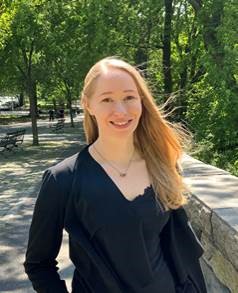“Prosthetic Control of Movement via Latent Neural Dynamics”
Karen Schroeder, PhD
Postdoctoral Research Scientist,
Churchland Lab at the Zuckerman Mind, Brain and Behavior Institute,
Columbia University
Wednesday, April 6th at 9:00 am
On Zoom
Registration required – Click here to register!

There remains significant clinical need to expand the type and complexity of movements that are decodable by brain-machine interface (BMI) systems. While progress in decoding is being made in several domains (arm reaching, speech), current systems do not generalize well across movements. This is in part due to an incomplete understanding of how activity in motor cortex and associated areas underlies movement planning and execution. Recent scientific findings, including our own, suggest that the intrinsic covariance structure of neural activity depends strongly on movement class. The traditional view holds that motor cortex is a very low-dimensional system that uses the same dimensions to produce outputs for all movements. However, recent results show that the system explores different neural dimensions during different movements (even those made with the same effector / body part). This geometry likely necessitates different decode algorithms across movement classes. To investigate most effective approach for decoding new kinds of movements, we analyzed cortical activity as monkeys performed non-reaching arm movements: cycling a hand-held pedal to progress along a virtual track. Unlike during reaching, we found no high-variance (large) dimensions that directly correlated with to-be-decoded variables. Counter to the traditional assumption, the dominant features of neural covariance are not kinematic signals, but instead serve a computational role. Despite this, we could decode a desired variable – self-motion – by non-linearly leveraging structure that spanned many high-variance neural dimensions that are specific to the cycling task. We directly confirmed this by demonstrating high performance real-time BMI control in two monkeys. Our results illustrate that different use-cases can require very different approaches to guiding a prosthetic based on decoded neural activity, and that high-variance, low-dimensional activity can be opportunistically leveraged for robust control. We are continuing to study the geometry of neural covariance for more complex versions of the task and in RNN models, both to understand the native control strategy implemented in motor cortex and to inform improved BMI decoding approaches.
Karen Schroeder is currently a postdoctoral fellow in the laboratory of Mark Churchland at Columbia University (department of Neuroscience). She currently holds a K99-R00 pathway to independence award from the NIH BRAIN Initiative. Her research is focused on the development of brain-computer interfaces in nonhuman primates, driven by a better understanding of how our brains plan and control movements. She completed her Ph.D. in Biomedical Engineering at the University of Michigan in 2016.
Biomedical Engineering Seminar Series
Bioengineering Elevated Talks: Celebrating 50 years of the Department of
Biomedical Engineering at the University of Utah